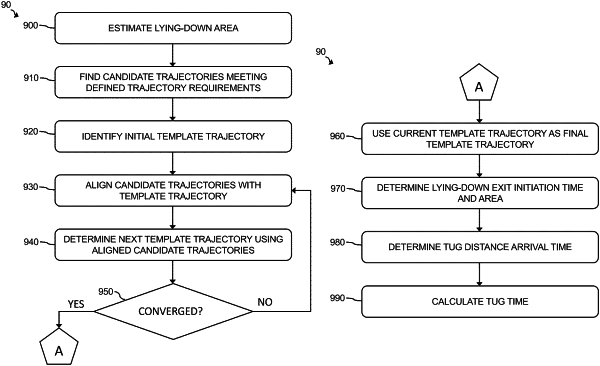| CPC A61B 5/1118 (2013.01) [A61B 5/11 (2013.01); A61B 5/1126 (2013.01); A61B 5/4809 (2013.01); G01S 7/41 (2013.01); G01S 13/34 (2013.01); G01S 13/343 (2013.01); G01S 13/89 (2013.01)] | 21 Claims |

|
1. A method for wireless detection of a subject rising from a rest state, comprising:
a. producing transmitted wireless signals from one or more transmitting antennas;
b. receiving reflected wireless signals at one or more receiving antennas, the reflected wireless signals being reflected from the subject partially or fully;
c. processing the reflected wireless signals in a computer to estimate a lying-down area of the subject, the computer including a microprocessor and memory electrically coupled to the microprocessor;
d. processing the reflected wireless signals in the computer to determine a plurality of candidate trajectories of the subject, each candidate trajectory corresponding to a movement of the subject over a time period;
e. aligning the candidate trajectories, in the computer, with an initial template trajectory;
f. determining, in the computer, a new template trajectory using the aligned candidate trajectories;
g. determining, in the computer, whether the new template trajectory is within a predetermined distance of the initial template trajectory;
h. when the new template trajectory is greater than the predetermined distance of the initial template trajectory:
replacing the new template trajectory with the initial template trajectory; and
repeating steps e-g until the new template trajectory is within the predetermined distance of the initial template trajectory;
i. when the new template trajectory is less than or equal to the predetermined distance of the initial template trajectory:
saving the new template trajectory as a final template trajectory;
determining, in the computer, a lying-down surface exit initiation area using the aligned candidate trajectories;
determining, in the computer, a lying-down surface exit initiation area exit time for each aligned candidate trajectory using the lying-down surface exit initiation area;
determining, in the computer, a time-up-and-go (TUG) plane entry time for each aligned candidate trajectory; and
calculating, in the computer, a TUG time based on a difference between the TUG plane entry time and the lying-down surface exit initiation area exit time.
|